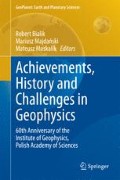Abstract
A new joint approach to deformations and motions in solids and fluids is presented. For the theory of solids, in addition to the shear and rotation strains, we define the molecular transport, while for fluids we consider the transport motions and the shear and rotation molecular strains. In this way we arrive at a common asymmetric theory for solids and fluids. Thus, for solids we present the release-rebound relations and related wave equations for strains, while for fluids we present the Navier-Stokes transport relations; moreover, for solids the included molecular transport and for fluids the molecular rotation and shear strains are considered additionally. The molecular transport in solids helps us to understand the fracture preparation processes. Of course, to each of these continua we include an influence of pressure; thus, in fluids we have both the pressure and its time derivative, that is, the molecular pressure related to sound phenomena.
Access this chapter
Tax calculation will be finalised at checkout
Purchases are for personal use only
References
Cosserat E, Cosserat F (1909) Théorie des Corps Déformables. A. Hermann et Fils, Paris
Droste Z, Teisseyre R (1959) The mechanism of earthquakes according to dislocation theory. Sci Rep Tohoku Univ Ser 5, Geophys 11(1):55–71
Eringen AC (1999) Microcontinuum field theories I, foundations and solids. Springer, Berlin, p 325
Eringen AC (2001) Microcontinuum field theories II, fluent media. Springer, Berlin, p 340
Eringen AC, Suhubi ES (1964) Non-linear theory of simple microelastic solids-1. Int J Eng Sci 2:189–203
Eshelby JD, Frank FC, Nabarro FRN (1951) The equilibrium of linear arrays of dislocations. Philos Mag 42:351–364
Gomberg J, Agnew DC (1996) The accuracy of seismic estimates of dynamic strains from pinyon flat observatory, California, strainmeter and seismograph data. Bull Seismol Soc Am 86:212–220
Kossecka E, DeWitt R (1977) Disclination kinematic. Arch Mech 29:633–651
Kröner E (1981) Continuum theory of defect. In: Balian R, Kleman M, Poirer JP (eds) Les Houches, session XXXV, 1980, physics of defects. North Holland, Amsterdam
Lee WHK, Celebi M, Todorovska MI, Igel H (2009) Introduction to special issue on rotational seismology and engineering applications. Bull Seismol Soc Am 62(2B):945–957
Mindlin RD (1965) On the equations of elastic materials with microstructure. Int J Solid Struct 1(1):73
Nowacki W (1986) Theory of asymmetric elasticity. Pergamon Press, PWN, Warszawa
Peach M, Koehler JS (1950) The forces exerted on dislocations and the stress fields produced by them. Phys Rev 80:436–439
Rybicki K (1986) Dislocations and their geophysical applications. In: Teisseyre R (ed) Continuum theories in solid earth physics. Elsevier-PWN, Warsaw, pp 18–186
Schreiber KU, Hautman JN, Velikoseltsev A, Wassermann J, Igel H, Otero J, Vernon F, Wells J-PR (2009) Ring laser measurements of ground rotations for seismology. Bull Seismol Soc Am 99(2B):1190–1198
Teisseyre KP (2007) Analysis of a group of seismic events using rotational components. Acta Geophys 55:535–553
Teisseyre R (1973) Earthquake processes in a micromorphic continuum. Pure Appl Geophys 102:15–28
Teisseyre R (1974) Symmetric micromorphic continuum: wave propagation, point source solutions and some applications to earthquake processes. In: Thoft-Christensen P (ed) Continuum mechanics aspects of geodynamics and rock fracture mechanics, pp 201–244
Teisseyre R (1980) Earthquake premonitory sequence—dislocation processes and fracturing. Boll Geofis Teor Appl 22:245–254
Teisseyre R (1985a) Creep-flow and earthquake rebound: system of the internal stress evolution. Acta Geophys Pol XXXIII(1):11–23
Teisseyre R (1985b) New earthquake rebound theory. Phys Earth Planet Inter 39(1):1–4
Teisseyre R (2008a) Introduction to asymmetric continuum: dislocations in solids and extreme phenomena in fluids. Acta Geophys 56:259–269
Teisseyre R (2008b) Asymmetric continuum: standard theory. In: Teisseyre R, Nagahama H, Majewski E (eds) Physics of asymmetric continua: extreme and fracture processes. Springer, Berlin, pp 95–109
Teisseyre R (2009) Tutorial on new development in physics of rotation motions. Bull Seismol Soc Am 99(2B):1028–1039
Teisseyre R (2010) Fluid theory with asymmetric molecular stresses: difference between vorticity and spin equations. Acta Geophys 58(6):1056–1071T
Teisseyre R (2011) Why rotation seismology: confrontation between classic and asymmetric theories. Bull Seismol Soc Am 101(4):1683–1691
Teisseyre R, Górski M (2009) Fundamental deformations in asymmetric continuum: motions and fracturing. Bull Seismol Soc Am 99(2B):1028–1039
Teisseyre R, Górski M (2011) Earthquake fragmentation and slip processes: spin and shear-twist wave mosaic. Acta Geophys 59(3):453–469
Teisseyre R, Górski M (2012) Induced strains and defect continuum theory: internal reorganization of load. Acta Geophys 60(1):24–42
Teisseyre R, Teisseyre-Jeleńska M (2014) Asymmetric continuum: extreme processes in solids and fluids. GeoPlanet Series, Springer, Berlin
Udias A (2002) Theoretical seismology: an introduction. In: Lee WHK, Kanamori H, Jennings PC, Kisslinger C (eds) International handbook of earthquake & engineering seismology, part a. Academic Press, New York, pp 81–102
Varotsos P, Alexopoulos K (1984a) Physical properties of the variations of the electric field of the earth preceding earthquakes, I. Tectonophysics 110:73–98
Varotsos P, Alexopoulos K (1984b) Physical properties of the variations of the electric field of the earth preceding earthquakes, II. Determination of epicenter and magnitude. Tectonophysics 110:99–125
Varotsos P, Alexopoulos K (1986) Thermodynamics of point defects and their relation with the bulk properties. Elsevier Science Ltd, North Holland
Zembaty Z (2009) Tutorial on surface rotations from wave passage effects: stochastic approach. Bull Seismol Soc Am 99(2B):1040–1049
Author information
Authors and Affiliations
Corresponding author
Editor information
Editors and Affiliations
Rights and permissions
Copyright information
© 2014 Springer International Publishing Switzerland
About this chapter
Cite this chapter
Teisseyre, R. (2014). Asymmetric Continuum Theory: Fracture Processes in Seismology and Extreme Fluid Dynamics. In: Bialik, R., Majdański, M., Moskalik, M. (eds) Achievements, History and Challenges in Geophysics. GeoPlanet: Earth and Planetary Sciences. Springer, Cham. https://doi.org/10.1007/978-3-319-07599-0_21
Download citation
DOI: https://doi.org/10.1007/978-3-319-07599-0_21
Published:
Publisher Name: Springer, Cham
Print ISBN: 978-3-319-07598-3
Online ISBN: 978-3-319-07599-0
eBook Packages: Earth and Environmental ScienceEarth and Environmental Science (R0)

